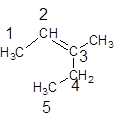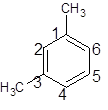
Concept explainers
(a)
Interpretation:
Whether the name 2-ethyl-2-butene is correct or not needs to be determined and the structure of the compound should be drawn.
Concept introduction:
The hydrocarbon compounds contain compound that are made up of only hydrogen and carbon atoms. Hydrocarbon compounds that contains multiple bond(s) are said to be
(a)
Answer to Problem 88A
The name 2-ethyl-2-butene is wrong and the correct name will be 3-methyl-2-pentene and the structure of the compound is:

Explanation of Solution
The given name of compound is 2-ethyl-2-butene so, from the name it can be concluded that the parent chain contains 4 carbon atoms with a double bond at position 2 and an ethyl substituent at carbon 2. So, the structure of the compound will be:

Now, according to IUPAC rules of naming of organic compound the longest carbon chain should be the parent chain containing double bond and substituents at lowest number so the numbering will be:

Hence, the name 2-ethyl-2-butene is wrong and the correct name will be 3-methyl-2-pentene.
(b)
Interpretation:
Whether the name 1, 4-dimethylcyclohexene is correct or not needs to be determined and the structure of the compound should be drawn.
Concept introduction:
The hydrocarbon compounds contain compound that are made up of only hydrogen and carbon atoms. Hydrocarbon compounds that contains multiple bond(s) are said to be unsaturated hydrocarbon. Compounds containing double bonds are said to be alkene whereas compounds containing triple bonds are said to be alkyne.
(b)
Answer to Problem 88A
The name 1, 4-dimethylcyclohexene is correct and the structure of the compound is:

Explanation of Solution
The given name of compound is 1, 4-dimethylcyclohexene so, from the name it can be concluded that the parent chain contains 6 carbon atoms cyclic ring with a double bond at position 1 and two methyl substituents at carbon 1 and 4. So, the structure of the compound will be:

Now, according to IUPAC rules of naming of organic compound the longest carbon chain should be the parent chain containing double bond and substituents at lowest number so the numbering will be:

Hence, the name 1, 4-dimethylcyclohexene is correct.
(c)
Interpretation:
Whether the name 1, 5-dimethylbenzene is correct or not needs to be determined and the structure of the compound should be drawn.
Concept introduction:
Benzene is an
(c)
Answer to Problem 88A
The name 1, 5-dimethylbenzene is wrong and the correct name will be 1, 3-dimethylbenzene and the structure of the compound is:

Explanation of Solution
The given name of compound is 1, 5-dimethylbenzene so, from the name it can be concluded that the parent chain is benzene cyclic ring and two methyl substituents at carbon 1 and 5. So, the structure of the compound will be:

Now, according to IUPAC rules of naming of organic compound the longest carbon chain should be the parent chain and substituents at lowest number so the numbering will be:

Hence, the name 1, 5-dimethylbenzene is wrong and the correct name will be 1, 3-dimethylbenzene.
Chapter 21 Solutions
Glencoe Chemistry: Matter and Change, Student Edition
Additional Science Textbook Solutions
Introductory Chemistry (6th Edition)
Microbiology: An Introduction
Anatomy & Physiology (6th Edition)
Campbell Biology (11th Edition)
Organic Chemistry (8th Edition)
Cosmic Perspective Fundamentals
- How can you prepare a 6 mL solution of 6% H2O2, if we have a bottle of 30% H2O2?arrow_forwardHow many mL of H2O2 from the 30% bottle must be collected to prepare 6 mL of 6% H2O2.arrow_forwardIndicate the product(s) B and C that are formed in the reaction: HN' OCH HC1 B + mayoritario C minoritario OCH3arrow_forward
- Indicate the product(s) that are formed in the reaction: NH-NH, OCH3 -H₂O OCH3arrow_forward21.38 Arrange the molecules in each set in order of increasing acidity (from least acidic to most acidic). OH OH SH NH2 8 NH3 OH (b) OH OH OH (c) & & & CH3 NO2 21.39 Explain the trends in the acidity of phenol and the monofluoro derivatives of phenol. OH OH OH OH PK 10.0 PK 8.81 PK 9.28 PK 9.81arrow_forwardidentify which spectrum is for acetaminophen and which is for phenacetinarrow_forward
- The Concept of Aromaticity 21.15 State the number of 2p orbital electrons in each molecule or ion. (a) (b) (e) (f) (c) (d) (h) (i) DA (k) 21.16 Which of the molecules and ions given in Problem 21.15 are aromatic according to the Hückel criteria? Which, if planar, would be antiaromatic? 21.17 Which of the following structures are considered aromatic according to the Hückel criteria? ---0-0 (a) (b) (c) (d) (e) (h) H -H .8.0- 21.18 Which of the molecules and ions from Problem 21.17 have electrons donated by a heteroatom?arrow_forward1. Show the steps necessary to make 2-methyl-4-nonene using a Wittig reaction. Start with triphenylphosphine and an alkyl halide. After that you may use any other organic or inorganic reagents. 2. Write in the product of this reaction: CH3 CH₂ (C6H5)₂CuLi H₂O+arrow_forward3. Name this compound properly, including stereochemistry. H₂C H3C CH3 OH 4. Show the step(s) necessary to transform the compound on the left into the acid on the right. Bri CH2 5. Write in the product of this LiAlH4 Br H₂C OHarrow_forward
- What are the major products of the following reaction? Please provide a detailed explanation and a drawing to show how the reaction proceeds.arrow_forwardWhat are the major products of the following enolate alkylation reaction? Please include a detailed explanation as well as a drawing as to how the reaction proceeds.arrow_forwardA block of zinc has an initial temperature of 94.2 degrees celcius and is immererd in 105 g of water at 21.90 degrees celcius. At thermal equilibrium, the final temperature is 25.20 degrees celcius. What is the mass of the zinc block? Cs(Zn) = 0.390 J/gxdegrees celcius Cs(H2O) = 4.18 J/gx degrees celcusarrow_forward
 ChemistryChemistryISBN:9781305957404Author:Steven S. Zumdahl, Susan A. Zumdahl, Donald J. DeCostePublisher:Cengage Learning
ChemistryChemistryISBN:9781305957404Author:Steven S. Zumdahl, Susan A. Zumdahl, Donald J. DeCostePublisher:Cengage Learning ChemistryChemistryISBN:9781259911156Author:Raymond Chang Dr., Jason Overby ProfessorPublisher:McGraw-Hill Education
ChemistryChemistryISBN:9781259911156Author:Raymond Chang Dr., Jason Overby ProfessorPublisher:McGraw-Hill Education Principles of Instrumental AnalysisChemistryISBN:9781305577213Author:Douglas A. Skoog, F. James Holler, Stanley R. CrouchPublisher:Cengage Learning
Principles of Instrumental AnalysisChemistryISBN:9781305577213Author:Douglas A. Skoog, F. James Holler, Stanley R. CrouchPublisher:Cengage Learning Organic ChemistryChemistryISBN:9780078021558Author:Janice Gorzynski Smith Dr.Publisher:McGraw-Hill Education
Organic ChemistryChemistryISBN:9780078021558Author:Janice Gorzynski Smith Dr.Publisher:McGraw-Hill Education Chemistry: Principles and ReactionsChemistryISBN:9781305079373Author:William L. Masterton, Cecile N. HurleyPublisher:Cengage Learning
Chemistry: Principles and ReactionsChemistryISBN:9781305079373Author:William L. Masterton, Cecile N. HurleyPublisher:Cengage Learning Elementary Principles of Chemical Processes, Bind...ChemistryISBN:9781118431221Author:Richard M. Felder, Ronald W. Rousseau, Lisa G. BullardPublisher:WILEY
Elementary Principles of Chemical Processes, Bind...ChemistryISBN:9781118431221Author:Richard M. Felder, Ronald W. Rousseau, Lisa G. BullardPublisher:WILEY





